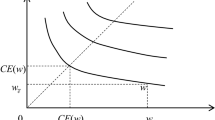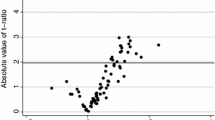Abstract
We consider the problem of choosing a location in an interval so as to best take into account the preferences of two agents who will use this location. One has single-peaked preferences and the other single-dipped preferences. The most preferred location for the agent with single-peaked preferences is known and it is the least preferred location for the agent with single-dipped preferences. We show that the only efficient and strategy-proof rules are dictatorial.


Similar content being viewed by others
Notes
Immaterial multiplicities occur when both participants are indifferent between the two endpoints of the interval of possible locations.
This is the game in which the strategy space of each agent is the space of their possible preferences, the outcome function is the function that associates with each strategy profile the location that the rule would select for that profile, and each agent evaluates outcomes in terms of their true preferences. For surveys of the literature on strategy-proofness see Barberà (2011) and Thomson (2022).
It is called a “contamination” step by Thomson (2022) to suggest that an unpleasant conclusion reached on a subdomain of preference profiles ends up permeating the entire domain.
On the entire domain \({\mathcal {R}}_1 \times {\mathcal {R}}_2\) the Pareto set could consist of a finite or countably infinite number of intervals.
A step in the proof of Zhou (1991) dictatorship result for such economies is that if one of the origins of the box is in the range of an efficient and strategy-proof rule, then the range is that origin. This means one agent always gets everything: they are the dictator. Schummer (1997) is another example. The argument does not apply to the n-agent case unless a property such as “non-bossiness” is required of rules.
If preferences are not so restricted, the Pareto set may be the disjoint union of more than two intervals. In fact, it may be the disjoint union of countably many intervals.
References
Alcalde-Unzu J, Vorsatz M (2018) Strategy-proof location of public facilities. Games Econom Behav 112:21–48
Barberà S (2011) Strategy-proof social choice. In: Arrow KA, Sen A, Suzumura K (eds) Handbook of social choice II. North-Holland, Amsterdam, pp 731–831
Barberà S, Berga D, Moreno B (2010) Individual versus group strategy-proofness: When do they coincide? J Econ Theory 145:1648–1674
Barberà S, Berga D, Moreno B (2012) Domains, ranges and strategy-proofness: the case of single-dipped preferences. Soc Choice Welfare 39:335–352
Carroll G (2012) When are local incentive constraints sufficient. Econometrica 80:661–686
Ching S (1997) Strategy-proofness and median voters. Int J Game Theory 26:473–490
Cho WJ (2016) Incentive properties for ordinal mechanisms. Games Econ Behav 95:165–177
Gibbard A (1973) Manipulation of voting schemes. Econometrica 41:587–601
Haeringer G, Halaburda H (2016) Monotone strategyproofness. Games Econ Behav 98:68–77
Manjunath V (2008) Anonymous, Pareto-efficient, and strategy-proof allocation rules for pure public good economies with single-dipped preferences. mimeo
Moulin H (1980) On strategy-proofness and single peakedness. Public Choice 35:437–455
Peremans W, Storcken T (1999) Strategy-proofness on single-dipped preference domains. In: de Swart H (ed) Logic, game theory and social choice. Tilburg University Press, Tilburg, pp 296–313
Sato S (2013) A sufficient condition for the equivalence of strategy-proofness and nonmanipulability by preferences adjacent to the sincere one. J Econ Theory 148:259–278
Satterthwaite M (1975) Strategy-proofness and Arrow’s conditions: existence and correspondence theorem for voting procedures and social choice functions. J Econ Theory 10:187–217
Schummer J (1997) Strategy-proofness versus efficiency on restricted domains of exchange economies. Soc Choice Welfare 14:47–56
Thomson W (2022) Strategy-proof allocation rules. Lecture notes
Zhou L (1991) Inefficiency of strategy-proof allocation mechanisms in pure exchange economies. Soc Choice Welfare 8:247–254
Funding
I thank the NSF for its support under Grant No. SES 0214691. First version: April 2008. I thank a referee, Wonki Jo Cho, Chang Woo Park, Yuki Tamura, and the audiences of seminar presentations at Bilkent University, Bilgi University, Hitostubashi University, the University of Lausanne, the University of Padua, the University Pablo de Olavide, and Vanderbilt University, on the occasion of a 2019 conference in the honor of John Weymark. I am most grateful to Eun Jeong Heo for her extensive comments.
Author information
Authors and Affiliations
Corresponding author
Ethics declarations
Conflict of interest
There is no conflict of interest to report.
Additional information
Publisher's Note
Springer Nature remains neutral with regard to jurisdictional claims in published maps and institutional affiliations.
Appendix
Appendix
This appendix is devoted to the straightforward but tedious proofof Lemma 1.
Step 1: Identifying the Pareto set in Case (i) of Lemma 1
Case (i): (Fig. 3). We first consider the location 0. We have already noted that \(e_1(0)\) exists. We have \(U^*_1(0)=]0,e_1(0)[\) and \(L^*_1(0)=]e_1(0), C]\). Also, \(U^*_2(0)=\emptyset\); if \(0 \mathrel {P_2} C\), \(L^*_2(0)=]0, C]\), and if \(0 \mathrel {I_2} C\), \(L^*_2(0)=]0, C[\). Making the father better off implies making the daughter worse off. The daughter cannot be made better off. Thus \(0\in E(R)\).
Let \(a\in ]0,h]\). Note that \(e_1(a)\) exists. We have \(U^*_1(a)=]a, e_1(a)[\) and \(L^*_1(a)=]0, a]\cup ]e_1(0), C]\). If \(e_2(a)\) does not exist, then \(U^*_2(a)=[0,a[\) and \(L^*_2(a)=]a,C]\). If \(e_2(a)\) exists and is equal to C, then \(U^*_2(a)=[0,a[\) and \(L^*_2(a)=]a,C[\). Otherwise, as is the case in Fig. 3, \(U^*_2(a)=[0,a[ \cup ]e_2(a), C]\) and \(L^*_2(a)=]a,e_2(a)[\). A simple calculation, which we omit (and we will omit the similar calculations that are needed to settle the other cases) shows that \(e_1(a) <e_2(a)\). In any case, making either the father or the daughter better off implies making the other agent worse off, so \(a \in E(R)\).
Let \(b\in ]h, e_1(0)]\). Then \(e_1(b)\) exists and \(U^*_1(b)=]e_1(b), b[\). Also, \(e_2(b)\) exists and \(U^*_2(b)=[0,e_2(b)[\cup ]b,C]\). Note that \(e_1(b) <e_2(b)\). Any point of \(]e_1(b), e_2(b)[\) Pareto-dominates b, so \(b \notin E(R)\).
Let \(c\in ]e_1(0), C[\). Then \(U^*_1(c)=[0,c[\). Also, \(U^*_2(c)=[0,e_2(c)[\cup ]c,C]\). Any point of \([0, e_2(c)[\) Pareto-dominates c, so \(c\notin E(R)\).
Finally \(U^*_1(C)=[0,C[\). If \(0 \mathrel {P_2} C\), \(U^*_2(c)=[0,e_2(c)[\) and \(L^*_2(C)=]e_2(C),C[\). Any point of \([0, e_2(c)[\) Pareto-dominates c, so \(c\notin E(R)\). If \(0 \mathrel {I_2} C\), \(U^*_2(c)=\emptyset\) and \(L^*_2(C)=]0,C[\). The location 0 Pareto-dominates C, so \(C\notin E(R)\).
Step 1: Identifying the Pareto set in Case (ii) of Lemma 1
Case (ii) (Fig. 4). Let \(a\in [0,h[\). Then \(e_1(a)\) exists. We have \(U^*_1(a)=]a,e_1(a)[\) and if \(a=0\), \(L^*_1(a)=]e_1(0),C]\) and otherwise \(L^*_1(a)=[0,a[\cup ]e_1(0),C]\). Also \(e_2(a)\) exists. If \(a=0\), \(U^*_2(a)=]e_2(0),C]\) and \(L^*_2(a)=]0, e_2(0)[\), and otherwise \(U^*_2(a)=[0,a[\cup ]e_2(a), C[\) and again \(L^*_2(a)=]a, e_2(a)[\). Note that \(e_1(a)<e_2(a)\). Making either the father or the daughter better off implies making the other agent worse off, so \(a \in E(R)\).
Let \(b\in ]h, e_1(0)]\). Then \(e_1(b)\) exists and \(U^*_1(b)= ]e_1(b),b[\). Also, \(e_2(b)\) exists and \(e_2(0)>0\); \(U^*_2(b)= [0, e_2(b)[\cup ]b,C]\). Thus, 0 Pareto-dominates b, so \(b \notin E(R)\).
Let \(c\in ]e_1(0), e_2(0)]\). Then \(U^*_1(c)=[0,c[\). Also, if \(c<e_2(0)\), \(U^*_2(c)= [0, e_2(c)[\cup ]c,C]\), and if \(c=e_2(0)\), \(U^*_2(c)= [0, e_2(c)[\). Again, 0 Pareto-dominates c, so \(c \notin E(R)\).
Let \(d\in \, ]e_2(0), C[\). Then \(U^*_1(d)=[0,d[\) and \(L^*_1(d) = ]d,C]\). Also, \(U^*_2(c)=]d,C]\); if \(d=e_2(0)\), \(L^*_2(d)=]0,e_2(0)[\) and if \(d>e_2(0)\), \(L^*_2(d)=[0,e_2(0)[\). Making either the father or the daughter better off implies making the other agent worse off, so \(d\in E(R)\). (Note that \(e_2(0)\) itself is Pareto dominated by 0; thus the Pareto set is not closed.)
Finally, \(U^*_1(C)=[0, C[\) and \(L^*_1(C)=\emptyset\). Also, \(U^*_2(C)=\emptyset\) and \(L^*_2(C)=[0,C[\). Making the father better off implies making the daughter worse off. The daughter cannot be made better off. Thus, \(C\in E(R)\).
Case (iii). The proof that \(E(R) =[0,C]\) is simply because both agents have exactly opposite preferences.
Case (iv) (Fig. 5). Let \(a<h\). Then \(e_1(a)\) exists and \(U^*_1(a)=]a,e_1(a)[\). Also, \(e_2(a)\) exists. If \(a=0\), \(U^*_2(a) = ]e_2(a), C]\) and if \(a>0\), \(U^*_2(a)=[0,a[\cup ]e_2(a),C]\). Note that \(e_2(a)<e_1(a)\). Any point of \(]e_2(a), e_1(a)[\) Pareto-dominates a, so \(a \notin E(R)\).
Let \(b \in ]h, e_2(0)]\). Then \(e_1(b)\) exists. We have \(U^*_1(b)=]e_1(b), b[\) and \(L^*_1(b)=[0,e_2(b)[\cup ]b,C]\). Also, \(e_2(b)\) exists. If \(b=e_2(0)\), then \(U^*_2(b)= ]e_2(b), C]\) and \(L^*_2(b)=]0,b[\); if \(b<e_2(b)\), \(U^*_2(b)=[0,e_2(b)[ \cup ]b, C]\) and \(L^*_2(b)=]e_2(b),b[\). Making either the father or the daughter better off implies making the other agent worse off, so \(b \in E(R)\).
Let \(c \in ]e_2(0), e_1(0)]\). Then \(e_1(c)\) exists. If \(c<e_1(0)\), then \(U^*_1(c)=]e_1(c), c[\) and \(L^*_1(c)= [0, e_1(c)[\cup ]c,C]\); if \(c=e_1(0)\), then \(U^*_1(c)=]0, e_1(0)[\) and \(L^*_1(c)= [e_1(0),C]\). Also, \(U^*_2(c)=]c, C]\) and \(L^*_2(c)=[0,c[\). Thus making either the father or the daughter better off implies making the other agent worse off, so \(c \in E(R)\).
Let \(d \in ]e_1(0), C[\). Then \(U^*_1(d)=[0, d[\) and \(L^*_1(d)=]d,C]\). Also, \(U^*_2(d)= ]d, C[\) and \(L^*_2(d)=[0,d[\). Making either the father or the daughter better off implies making the other agent worse off, so \(d \in E(R)\).
Finally, \(U^*_1(C)=[0,C[\) and \(L^*_1(C)=\emptyset\). Also, \(U^*_2(C)=\emptyset\) and \(L^*_1(C)=[0,C[\). Making the father better off implies making the daughter worse off. The daughter cannot be made better off. Thus, \(C \in E(R)\).
\(\square\)
Step 1: Identifying the Pareto set in Case (iv) of Lemma 1
Rights and permissions
Springer Nature or its licensor (e.g. a society or other partner) holds exclusive rights to this article under a publishing agreement with the author(s) or other rightsholder(s); author self-archiving of the accepted manuscript version of this article is solely governed by the terms of such publishing agreement and applicable law.
About this article
Cite this article
Thomson, W. Where should your daughter go to college? An axiomatic analysis. Soc Choice Welf 60, 313–330 (2023). https://doi.org/10.1007/s00355-022-01438-y
Received:
Accepted:
Published:
Issue Date:
DOI: https://doi.org/10.1007/s00355-022-01438-y







